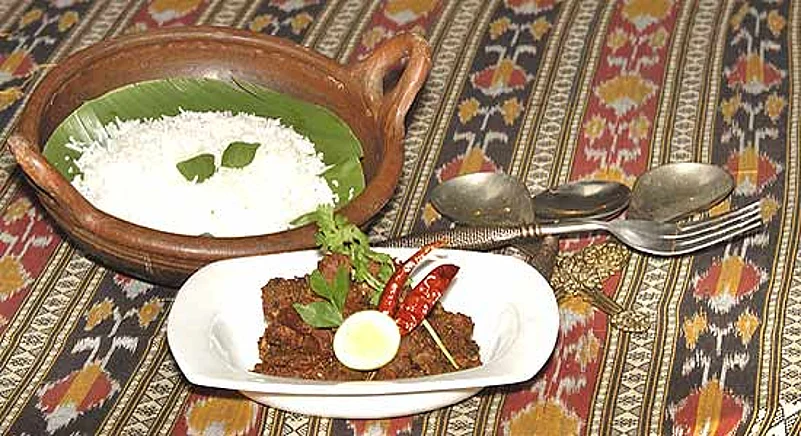There’s a lot more to Hyderabadi food than just biriyani. Hyderabad is home to not one, but two of India’s famous cuisines: Hyderabadi and Andhra. The former is a product of history, the latter of geography.
The story of Hyderabadi cuisine begins in the 17th century, with the Deccan campaigns. The Mughal armies annexed great swathes of southern India over nearly a century. What we don’t realise, though, is that those armies were accompanied by large caravans of soldiers’ families and assorted tradesmen and craftsmen. While the soldiers fought, in the family encampments, domestic life went on. Bazaars were set up, food was cooked, families were raised. Here, over the years, the Mughlai cuisine brought from the north slowly evolved, influenced by the local ingredients, climate and cuisines encountered along the way. (In the same way, the Urdu spoken in these encampments evolved into the Dakhni dialect, influenced by Telugu, Marathi and Kannada—but that’s another story.)
The result of this historical process was Hyderabadi cuisine—a unique dialect of Mughlai cuisine, distinct from the other Mughlai dialects of Delhi, Lucknow or Bhopal: it’s somewhat more robust; it uses typically South Indian ingredients; it uses rice as a staple, instead of roti. But its singlemost important distinguishing feature is the way it uses “khatta”, or a sourness factor, in its dishes.
The central point of Hyderabadi cuisine is a khatta saalan, or curry with a tangy flavour provided by tamarind, green mango, lemon, tomato or even pomegranate. Many of Hyderabad’s most famous delicacies belong to this category, such as baghare baingan (spiced brinjal curry) or mirchon ka saalan (chilli curry), and every menu is planned around khatta saalans like these. The khatta factor is, in fact, rooted in ancient science: it helps stimulate the digestive system in the hot climate of the Deccan and somehow works at a chemical level to counter the richness of the Hyderabadi diet.
Hyderabad was a very wealthy kingdom, and it fostered an appropriately ornate culture. And, as in France, one of the key components of that culture—as important as its architecture, poetry, art and etiquette—was its cuisine. It was an art form, both in the way it was created, and the way it was appreciated.
A legendary old, retired family cook once came to visit us. We took the opportunity to ask him to cook his famous pulao for us. He reluctantly agreed, and gave us a list of the ingredients he would need. For eight people he wanted a quarter seer of cream, a quarter seer of khoya, a spoonful of saffron, a spoonful of rose petals, a fistful of almonds...plus the usual ingredients like rice, mutton and ghee. We made the mistake of asking if that wouldn’t become a bit too rich to digest. The old man got very upset. “Then let it be, sahib,” he said, frostily, “but that”—he paused for effect—“is how a pulao is supposed to be made.” He sulked and refused to cook for us that day. You cannot have art without the artists.

Getting chillli Dumpada Mamsam, a Telangana mutton speciality
Hyderabad has been called the exact point where North India meets South India. So it’s only natural that Hyderabadi cuisine coexists side by side with Andhra cuisine in the kitchens of the city. The themes that run through it are rice from the lush Godavari delta; tamarind and green mango that grow in abundance here; and lots of spices, from the south. In the east, there is excellent seafood, but otherwise the cuisine is largely vegetarian, with a special taste for brinjal, lady’s finger, drumstick and tomato. More importantly, this is one of India’s main chilli-growing regions, so it’s no surprise that the cuisine is one of the hottest in the world. The Guntur “fire-stick” chilli is so hot it’s sometimes used by the police to torture prisoners, and its molecules are not water-soluble, so its fire cannot be doused with water. Which is why an Andhra meal always ends with a dollop of curd-rice—the traditional secret for dissolving the chilli molecules with fat.
To be accurate, however, one should not speak of Andhra cuisine, one should speak of cuisines—in the plural—for there are actually three different sub-cuisines: from Telangana, coastal Andhra and Rayalaseema, respectively. The first is influenced by Hyderabad’s Muslim cuisine; the second places an emphasis on the region’s wonderful seafood; the third is even more fiery than the other two, in keeping perhaps with the aggressive, macho culture of that region. Unlike Hyderabadi cuisine, Andhra cuisine never had the advantage of court patronage, which played an important role in the evolution of certain Indian cuisines. Instead, it was always essentially the food of the common man—which is why it remained so simple, earthy and robust. (It is interesting to wonder what would have happened if, for example, the aristocracy of Telangana had asserted more culinary independence, instead of adopting Mughlai cuisine? Or if the intrinsically Telugu Vijayanagara empire had survived a couple of centuries longer?)
Some years ago Camellia Panjabi had set up an interesting new restaurant in Hyderabad, called Dakhni, which attempted to recreate the old cuisines of the Deccan, from places like Telangana and Bijapur. An exciting concept but, alas, it never took off. Today, Andhra cuisine is on an upswing, as is obvious from the growing popularity of Andhra restaurants in other parts of India, as well. Hyderabadi cuisine, on the other hand, is in slow decline. It was never available in eating houses, only in people’s homes. But the traditional cooks in those homes are now fading into the sunset, and the women of the house are no longer able to pursue the cuisine with the time and commitment that it requires. The result is that the everyday food that’s eaten today is increasingly of the generic dal-chawal-chicken-curry variety. In a decade or so, one of India’s great cuisines may well be extinct. And that is the pity.
(Anvar Alikhan is a Hyderabad-based advertising professional and writer.)
















